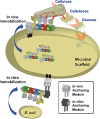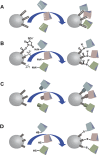Design of nanoscale enzyme complexes based on various scaffolding materials for biomass conversion and immobilization
- PMID: 27783468
- PMCID: PMC5132044
- DOI: 10.1002/biot.201600039
Design of nanoscale enzyme complexes based on various scaffolding materials for biomass conversion and immobilization
Abstract
The utilization of scaffolds for enzyme immobilization involves advanced bionanotechnology applications in biorefinery fields, which can be achieved by optimizing the function of various enzymes. This review presents various current scaffolding techniques based on proteins, microbes and nanomaterials for enzyme immobilization, as well as the impact of these techniques on the biorefinery of lignocellulosic materials. Among them, architectural scaffolds have applied to useful strategies for protein engineering to improve the performance of immobilized enzymes in several industrial and research fields. In complexed enzyme systems that have critical roles in carbon metabolism, scaffolding proteins assemble different proteins in relatively durable configurations and facilitate collaborative protein interactions and functions. Additionally, a microbial strain, combined with designer enzyme complexes, can be applied to the immobilizing scaffold because the in vivo immobilizing technique has several benefits in enzymatic reaction systems related to both synthetic biology and metabolic engineering. Furthermore, with the advent of nanotechnology, nanomaterials possessing ideal physicochemical characteristics, such as mass transfer resistance, specific surface area and efficient enzyme loading, can be applied as novel and interesting scaffolds for enzyme immobilization. Intelligent application of various scaffolds to couple with nanoscale engineering tools and metabolic engineering technology may offer particular benefits in research.
Keywords: Cell surface anchoring; Designer enzyme; Nanoparticle; Scaffold; Whole-cell biocatalyst.
© 2016 The Authors. Biotechnology Journal published by WILEY-VCH Verlag GmbH & Co. KGaA, Weinheim.
Figures





Similar articles
-
A review of nanotechnology in enzyme cascade to address challenges in pre-treating biomass.Int J Biol Macromol. 2024 Jun;270(Pt 2):132466. doi: 10.1016/j.ijbiomac.2024.132466. Epub 2024 May 16. Int J Biol Macromol. 2024. PMID: 38761904 Review.
-
Enzyme immobilization with nanomaterials for hydrolysis of lignocellulosic biomass: Challenges and future Perspectives.Carbohydr Res. 2024 Sep;543:109208. doi: 10.1016/j.carres.2024.109208. Epub 2024 Jul 14. Carbohydr Res. 2024. PMID: 39013334 Review.
-
Nanotechnology and enzyme immobilization: a review.Nanotechnology. 2023 Jul 3;34(38). doi: 10.1088/1361-6528/acda35. Nanotechnology. 2023. PMID: 37257425 Review.
-
[Advances in capillary-based immobilized enzyme microreactor based on DNA-directed immobilization].Se Pu. 2020 Oct 8;38(10):1206-1210. doi: 10.3724/SP.J.1123.2020.05035. Se Pu. 2020. PMID: 34213117 Chinese.
-
Multi-point enzyme immobilization, surface chemistry, and novel platforms: a paradigm shift in biocatalyst design.Crit Rev Biotechnol. 2019 Mar;39(2):202-219. doi: 10.1080/07388551.2018.1531822. Epub 2018 Nov 4. Crit Rev Biotechnol. 2019. PMID: 30394121 Review.
Cited by
-
Enzyme Cascade Electrode Reactions with Nanomaterials and Their Applicability towards Biosensor and Biofuel Cells.Biosensors (Basel). 2023 Dec 7;13(12):1018. doi: 10.3390/bios13121018. Biosensors (Basel). 2023. PMID: 38131778 Free PMC article. Review.
-
Stabilizing displayed proteins on vegetative Bacillus subtilis cells.Appl Microbiol Biotechnol. 2018 Aug;102(15):6547-6565. doi: 10.1007/s00253-018-9062-x. Epub 2018 May 23. Appl Microbiol Biotechnol. 2018. PMID: 29796970 Free PMC article.
-
Sustainable green approach to synthesize Fe3O4/α-Fe2O3 nanocomposite using waste pulp of Syzygium cumini and its application in functional stability of microbial cellulases.Sci Rep. 2021 Dec 21;11(1):24371. doi: 10.1038/s41598-021-03776-w. Sci Rep. 2021. PMID: 34934128 Free PMC article.
-
Study of the inhibition effects on glutathione peroxidase immobilized on MNPs using a stopped-flow microfluidic system.Anal Bioanal Chem. 2023 May;415(11):2091-2100. doi: 10.1007/s00216-023-04521-0. Epub 2023 Jan 18. Anal Bioanal Chem. 2023. PMID: 36651974 Free PMC article.
-
Current perspective on production and applications of microbial cellulases: a review.Bioresour Bioprocess. 2021 Oct 5;8(1):95. doi: 10.1186/s40643-021-00447-6. Bioresour Bioprocess. 2021. PMID: 38650192 Free PMC article. Review.
References
-
- Yu, K. O. , Kim, S. W. , Han, S. O. , Engineering of glycerol utilization pathway for ethanol production by Saccharomyces cerevisiae . Bioresour. Technol. 2010, 101, 4157–4161. - PubMed
-
- Galbe, M. , Zacchi, G. , A review of the production of ethanol from softwood. Appl Microbiol. Biotechnol. 2002, 59, 618–628. - PubMed
-
- Jorgensen, H. , Kutter, J. P. , Olsson, L. , Separation and quantification of cellulases and hemicellulases by capillary electrophoresis. Anal. Biochem. 2003, 317, 85–93. - PubMed
-
- Tokuhiro, K. , Ishida, N. , Kondo, A. , Takahashi, H. , Lactic fermentation of cellobiose by a yeast strain displaying beta‐glucosidase on the cell surface. Appl. Microbiol. Biotechnol. 2008, 79, 481–488. - PubMed
Publication types
MeSH terms
Substances
LinkOut - more resources
Full Text Sources
Other Literature Sources

